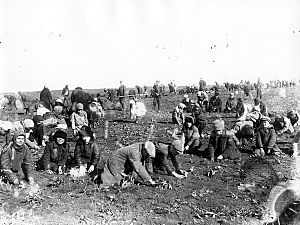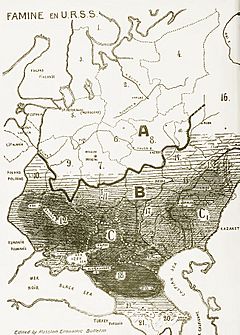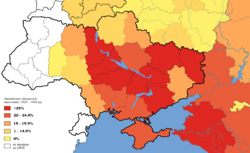Holodomor facts for kids

The Holodomor (Ukrainian: Голодомор, which means "murder by hunger") was a man-made famine and possibly a genocide that happened in Ukraine in 1932 and in 1933. At that time, Ukraine was a part of the Soviet Union. About seven million people starved to death in the Holodomor.
Joseph Stalin was the leader and dictator of the Soviet Union, which was a communist country. He made farmers in the Soviet Union change the way they farmed, then he tried to make the farmers work harder for the government-owned farms, for less money. Many people in the Ukraine did not want to go along with this. When the Ukraine had a famine, Stalin refused to help the people in the Ukraine. Instead, the government took food away from people. It became illegal (against the law) to pick up food from the ground of fields. The government also tried to stop people from moving around the country to look for food.
Scholars and politicians using the word Holodomor say the man-made aspects of the famine, was a genocide; some consider the huge loss of life comparable to the Holocaust. They argue that the Soviet policies were an attack on the rise of Ukrainian nationalism and therefore is a genocide.
Other scholars say that the Holodomor was an unexpected consequence of the rapid and massive industrialization started by Stalin, that brought radical economic changes to the farmers and the country, and which was not done on purpose.
Etymology
Holodomor literally translated from Ukrainian means "death by hunger." The expression holodom moryty means "to inflict death by hunger."
It was used in print in the 1930s in Ukrainian diaspora publications in Czechoslovakia as Haladamor, and by Ukrainian immigrant organisations in the United States and Canada by 1978; in the Soviet Union, of which Ukraine was a constituent republic, any references to the famine were dismissed as anti-Soviet propaganda, even after de-Stalinization in 1956, until the declassification and publication of historical documents in the late 1980s made continued denial of the catastrophe unsustainable
Discussion of the Holodomor became possible as part of the glasnost policy of openness. In Ukraine, the first official use of famine was a December 1987 speech by Volodymyr Shcherbytskyi, First Secretary of the Central Committee of the Communist Party of Ukraine, on the occasion of the republic's 70th anniversary.
The term holodomor may have first appeared in print in the Soviet Union on 18 July 1988. Holodomor is now an entry in the modern, two-volume dictionary of the Ukrainian language, published in 2004, described as "artificial hunger, organised on a vast scale by a criminal regime against a country's population."
According to Elazar Barkan, Elizabeth A. Cole, and Kai Struve, the Holodomor has been described as a “Ukrainian Holocaust".
Scope and duration
The famine affected the Ukrainian SSR as well as the Moldavian Autonomous Soviet Socialist Republic (a part of the Ukrainian SSR at the time) in spring 1932, and from February to July 1933, with the most victims recorded in spring 1933. The consequences are evident in demographic statistics: between 1926 and 1939, the Ukrainian population increased by only 6.6%, whereas Russia and Belarus grew by 16.9% and 11.7%, respectively.
From the 1932 harvest, Soviet authorities were able to procure only 4.3 million tons as compared with 7.2 million tons obtained from the 1931 harvest. Rations in towns were drastically cut back, and in winter 1932–1933 and spring 1933, people in many urban areas starved. Urban workers were supplied by a rationing system and therefore could occasionally assist their starving relatives in the countryside, but rations were gradually cut. By spring 1933, urban residents also faced starvation.
Causes
The overlying causes for the famine are still disputed. Some scholars suggest that the famine was a consequence of human-made and natural factors. The most prevalent human-made factor was the economic problems associated with changes implemented during the period of Soviet industrialisation. There are also those who blame a systematic set of policies perpetrated by the Soviet government under Stalin designed to exterminate the Ukrainians. According to historian Stephen G. Wheatcroft, the grain yield for the Soviet Union preceding the famine was a low harvest of between 55 and 60 million tons, likely in part caused by damp weather and low traction power, yet official statistics mistakenly reported a yield of 68.9 million tons.
The collectivization and high procurement quota explanation for the famine is somewhat called into question by the fact that the oblasts of Ukraine with the highest losses were Kyiv and Kharkiv, which produced far lower amounts of grain than other sections of the country.
In Ukraine collectivisation policy was enforced, entailing extreme crisis and contributing to the famine. In 1929–1930, peasants were induced to transfer land and livestock to state-owned farms, on which they would work as day-labourers for payment in kind. Collectivization in the Soviet Union, including the Ukrainian SSR, was not popular among the peasantry, and forced collectivisation led to numerous peasant revolts. The first five-year plan changed the output expected from Ukrainian farms, from the familiar crop of grain to unfamiliar crops like sugar beets and cotton. In addition, the situation was exacerbated by poor administration of the plan and the lack of relevant general management. Significant amounts of grain remained unharvested, and—even when harvested—a significant percentage was lost during processing, transportation, or storage.
In the summer of 1930, the government instituted a program of food requisitioning, ostensibly to increase grain exports. Food theft was made punishable by death or 10 years imprisonment. Food exports continued during the famine, albeit at a reduced rate. In regard to exports, Michael Ellman states that the 1932–1933 grain exports amounted to 1.8 million tonnes, which would have been enough to feed 5 million people for one year.
Under the collectivism policy, for example, farmers were not only deprived of their properties but a large swath of these were also exiled in Siberia with no means of survival.
Death toll
The Soviet Union long denied that the famine had taken place. The NKVD (and later KGB) controlled the archives for the Holodomor period and made relevant records available very slowly. The exact number of the victims remains unknown and is probably impossible to estimate even within a margin of error of a hundred thousand.
During an international conference held in Ukraine in 2016, Holodomor 1932–1933 loss of the Ukrainian nation, at the National University of Kyiv Taras Shevchenko, it was claimed that during the Holodomor 7 million Ukrainians were killed, and in total, 10 million people died of starvation across the USSR.
| List of countries which officially recognize the Holodomor as genocide | ||
|---|---|---|
|
|
||
Images for kids
-
"Light the candle" event at a Holodomor memorial in Kiev, Ukraine
-
Memorial at the Andrushivka village cemetery, Vinnytsia Oblast, Ukraine
-
Memorial in Poltava Oblast, Ukraine
-
Memorial cross in Dnipropetrovsk, Ukraine
-
Viktor Yanukovych and Dmitry Medvedev at the Memorial to the Holodomor Victims in Kiev, Ukraine
-
A "black board" published in the newspaper "Under the Flag of Lenin" in January 1933—a "blacklist" identifying specific kolhozes and their punishment in the Bashtanka Raion, Mykolayiv oblast, Ukraine.
-
A "Red Train" of carts from the "Wave of Proletarian Revolution" collective farm in the village of Oleksiyivka, Kharkiv oblast in 1932. "Red Trains" took the first harvest of the season's crop to the government depots. During the Holodomor, these brigades were part of the Soviet Government's policy of taking away food from the peasants.
-
.
Starvation during the Holodomor, 1933
-
Candles and wheat as a symbol of remembrance during the Holodomor Remembrance Day 2013 in Lviv
-
Memorial cross in Kharkiv, Ukraine
-
Memorial cross in Dolotetske, Vinnytsia Oblast, Ukraine
-
Holodomor Memorial in Dovhalivka, Vinnytsia Oblast, Ukraine
-
"Barrow of Sorrows" monument in Mhar, Poltava Oblast, Ukraine
-
Roman Kowal's Holodomor Memorial in Winnipeg, Canada
-
1983 Holodomor Monument in Edmonton, Canada (first in the world)
-
Plaque in Grand Park, Los Angeles, California, United States
-
Holodomor Monument in Calgary, Canada
See also
 In Spanish: Holodomor para niños
In Spanish: Holodomor para niños



























